|
Click Here for Birding Photos
Tuesday 30 June, 2009
The fledgling Purple Martins started learning to fly on 20 June here in our yard. On 22 June, 240 Brown Pelicans were seen on the PINS beach
front and this is birds through nesting. Small numbers of Little Blue and Tri-colored Herons are now seen daily migrating to the South but just
1 to 4 per day. On 23 June I saw a Brown Noddy (very probably the same bird I saw earlier this month) 4 miles offshore of the 5 mile PINS beach
while on a nearshore fishing charter. Long-billed Curlews began to show up post breeding on 24 June and I had a beautiful adult Masked Booby
at the 52 mile beach at 3:45 pm. Red Knots were seen through 25 June, when I counted 94 individuals. Since that date none have been seen.
Black Terns are in good supply and Caspian, Royal, Sandwich, Least and an occasional Gull-billed Tern are seen daily as are a few Black Skimmers.
Willets are beginning to be seen in flocks of 5 to 15 and probably these are returning birds post breeding. Numbers of birds on the beach will
gradually increase from mid July on into the Fall.
Buff-bellied and Black-chinned Hummngbirds are regular in my yard along the the other "home boy" Golden-fronted Woodpeckers, American Cardinals,
Inca, Mourning, White-winged and Eurasian-collared Doves. Sure is hot out there.
Have a good 4th. of July weekend. Capt. Billy
.jpg)
Wednesday 24 June, 2009
On PINS today I saw 15 Red Knots. These birds must be non-breeders. None were in breeding plumage. 6 Long-billed Curlews, The Brown Pelicans
are showing up post breeding with about 250 seen on the beach. Numerous Black Skimmers. 4 Little Blue Herons. 800 to 1,000 Black Terns, 2
Common Terns and other Tern species. As I look at this pic of Inca Doves in my yard I realize why my bird seed bill was $142, recently.
Capt. Billy
.jpg)
Thursday 18 June, 2009
Terns, Laughing Gulls and small numbers of several species of shorebirds are all that are currently on PINS. 3 Long-billed Curlews, 2 Common
Terns and 150 + Black Terns were seen as were Caspian, Sandwich, Least and a couple of Forester's. Scattered Brown Pelicans, Willets and
Black-bellied Plover were seen as were numerous Wilson's Plover. The Wilson's Plover nest on the island. One staging flock of 60+ Sanderlings
and a few Ruddy Turnstones remain. Here at the house we have male Black-chinned and Buff-bellied Hummingbirds and the usual. Eurasian-collared
doves are everywhere nowadays but we have one unlike any other I have so far seen. It is a typical bird other than it lacks the collar.
I'm curious if it is a hybrid.
Good birding. Capt. Billy
.JPG)
Tuesday 16 June, 2009
The winds have been in excess of 30 mph daily since the last update. Curtailed both quality birding and fishing. Did see the first ever Summer
Black-throated male Hunningbird we've ever had here at the house. 2 females are around most Summers but this is a first for the male. Buff-bellied
Hummingbirds, Northern Cardinals, Golden-fronted Woodpeckeers and Mourning, Eurasian-collared and Inca Doves fill the yard as do Great-tailed
Grackles. Down the beach tomorrow so hope to see you's about down island.
Mel Cooksey reports that Gene Blacklock found a Jabiru (huge stork of Central and South America, accidental straggler to south Texas) on Wed. 10
June and Thurs. 11 June on the Old McGregor Ranch between Odem and the Nueces River. This is an awful good bird for Texas.
Capt. Billy L. Sandifer
Below is a late migrating Yellow-crowned Night Heron photographed on PINS.
.jpg)
Thursday 11 June, 2009
Seas are big and the tides are high so driving is difficult. We observed and photoed this extremely worn plumage Brown Noddy at the 9 1/2 mile
beach at 08:30 am. I'm told this is the 20th. sighting of this species in Texas. 46 Red Knots were observed between the 17 and 19 mile.
2 Common Terns, 2 Long-billed Curlew and 3 Willets were observed along with a few Black Terns, 1 Black-bellied Plover, sanderlings, Wilson's
Plover, Ruddy Ternstones and Gull-billed, Sandwich, Forester's, Royal, Least and Caspian Terns and 1 Brown Pelican. This is the time of year
when there are the least numbers of birds on the shoreline as most are on nests.
Enjoy Capt. Billy L. Sandifer
.jpg)
Tuesday 9 June, 2009
The pic on the left is a 7' alligator in Agua Dulce creek. 2nd is Rosette Spoonbills, Cattle Egrets and Snowy Egrets nesting on Wright's pond near Old San
Patricio. Mel Cooksey and I did a survey of nesting birds in Western Nueces today and saw 61 species. The highlite of our half day adventure was an adult
Audubon's Oriole which is extremely unusual this far East. Other highlites were Groove-billed Ani, Green Jays, Fulvous Whistling Ducks, Verdin,
Olive Sparrows, Clapper Rail, Cassin's Sparrows, Swainson's Hawk, Fuerte's Red-tailed Hawk and 2 late season semi-palmated Sandpipers. Painted
Buntings were calling every where the whole time we were in the brush country as were White-eyed Vireo. Mammals seen included White-tailed Deer,
Javelina and Coyote. I'm chartered fishing for 20 of the next 22 days so it will be beach bird reports for a while.
Enjoy Capt. Billy L. Sandifer
.jpg)
.jpg)
Thursday 4 June, 2009
Mel Cooksey reports seeing a Hooded Oriole in the 6000 block of Ebonwood. 1 1/2 block West of Ennis Joslin in Corpus Christi. There is a history
of nesting Hooded Orioles at this location. Watch in the tall Palm trees. That is an awful good bird for this far North in Texas. Mel also
reports an early Wood Stork on 31 May at Tule Lake in Corpus Christi.
On PINS I had 53 Red Knots today, 4 June. All at the 17 1/2 mile beach. Many species are absent now as they have moved North to nest. Good
numbers of a variety of Terns and Laughing Gulls remain along with a few non breeding shorebirds. One Tri-Color and 12 Cattle Egrets were
seen still migrating in from the South today. There is a Buff-bellied Hummingbird living in my yard as it does every Summer and Northern
Cardinals and Golden -fronted Woodpeckers are daily visitors along with Inca, White-winged, Mourning and Eurasian-collar Doves.
The pic below shows the head and upper body of a male Painted Bunting coming to our yard to drink daily.
Capt. Billy L. Sandifer
.jpg)
Monday 1 June, 2009
Friday, the 29th. of May 55 Red Knots were observed but on Saturday the number had increased to 190 individuals. All between the 16 1/2
mile and the 26 mile beach. A few single Dunlin remain but the staging flocks of Sanderlings and Willets are gone. Curlews were absent
as well. On Saturday at the 32 mile I had what I believe was a Brown Booby fly by far offshore but could not get to my binoculars in
time to get a solid id and it could have been a juvenile of another species although I don't think so.
We have Archilocus and Buff-bellied Hummingbirds in the yard daily along with one male Painted Bunting that comes to water daily. Probably
his mate has a nest nearby. The Inca Doves have 2 nests in the yard and there are lots of Mourning and Eurasian Collared Doves and White-winged.
Cardinals and Golden-fronted Woodpeckers are here most of the day.
Several species of Terns on the PINS beachfront on Sat. May 30,09. Common, both male and female Black, Sandwich and Forresters are shown
along with Laughing Gulls in Summer plumage.
Capt. Billy L. Sandifer
.jpg)
Thurs. 28 May, 2009
Dunlin still remain on the Padre Island beachfront as do Common Terns and all of our typical Terns Species including Skimmers. Heading into
Corpus Christi upon leaving North Padre Island if you will look at the LAST spoil island on the right side before reaching Flour Bluff
there is a large nesting colony of Black Skimmers there. The picture below is a dunlin in breeding plumage.
The Spring neo-tropical migration will continue into early June but it is winding down. Mel Cooksey reports seeing Grey Catbirds, Mourning
Warblers, American Redstarts and Swainsons Thrush at Blucher Park in Corpus yesterday. Out here in Flour Bluff it's been Empidonax
Flycatchers, Archilochus and Buff-bellied Hummingbirds and we have one nesting Couch's Kingbird in the neighbor's Cottonwood tree.
Jay Gardner is getting Less American Goldfinches in the Southern part of Flour Bluff and that is late for these birds here. The Cedar
Waxwings have (as of now) not arrived for their annual feasting on our Russian Mulberry Tree and are expected any day. I'm down island
the next 4 days and should have some goodies to share when I return.
Have a good weekend. Capt. Billy
.jpg)
Sun. 24 May, 2009
On Sunday, 24 May on PINS I had 142 Red Knots, 1 Canada Warbler, 2 Spotted Sandpipers, 15 Common Terns and the usual. A few Dunlin
remain but less all the time and over a thousand Black Terns were observed in groups ranging from 50 - 200 birds. We only went to
the 32 mile beach due to the number of beach visitors present. Below is the report Mel Cooksey sent to me.
Mel Cooksey reported sightings of a Red-necked Phalarope female breeding plumage at Birding Center in Port A. A Black-billed Cuckoo at
Rose Hill and Paradise Pond. A variety of birds in all migrant traps. Major numbers of empids, Great-crested Flycatchers, Red-eyed
Vireos, and all of the late warblers.
Capt. Billy L. Sandifer
Thurs. 21 May, 2009
The highlight of the day is the pictured immature Masked Booby in heavy molt sitting on the beach at the 26 mile beach at 5 p.m.
Dunlin remain in high numbers. All typical Tern species are still present including 4 Common Terns. Large numbers of Black Terns
remain in flocks of 50 to 150 individuals. 25 Black Skimmers, 41 Red Knots, 60 Brown Pelicans, 2 Green Herons, 30 Cattle Egrets,
4 Spotted Sandpipers, 3 Semipalmated Sandpipers and Snowy, Piping, Wilson's and Blackbellied Plovers were also observed. Sanderlings
continue to be present in large flocks of up to 150 individuals but the overall numbers of Ruddy Turnstones and Blackbellied Plover
are declining. Most of the Wintering Gulls are gone now except for a few juveniles.
Have a good holiday. Capt. Billy
.jpg)
Mon. 18 May, 2009
On Friday, 15 May, 09, we traveled the length of the PINS beach. Many species have migrated on through the area and are declining in
number. Many are already on nests. Sanderlings were observed in several staging flocks of several hundred birds each, 84 Red Knots,
2 Common Terns, all of our typical tern species and 6 Skimmers were observed as were Ruddy Turnstones, Willets, Black-bellied and Snowy
Plover and a few remaining Dunlin. 200 Cattle Egrets and 1 Tri-Colored Heron were observed migrating North.
The previously promised Neo-Tropical Fallout for last Sunday and Monday was a good one with many good birds being seen in the local area.
Mel Cooksey reported sightings including all 5 of the Empidonax Flycatchers, 1 Black-throated Blue Warbler, Canada, Redstarts, Chestnut-sided, Yellow and
Baybreasted Warblers. Cedar Waxwings, 1 Black-billed Cuckoo and 2 Western Tanagers. The Western Tanagers have been unusually common
this Spring and the two remain at Paradise Pond in Port Aransas as of this writing. White-rumped Sandpipers are also migrating through.
As I write this I see a Grey Cheeked Thrush outside my window. Numerous Archilochus female Hummingbirds, one male Ruby-throated and one
Buff-bellied are also present in my yard. Truth of it is that the Spring migration is winding down now and we will see less numbers of
species although June is THE month for possibly seeing a very rare Brown Noddy on the beach of PINS. Magnificent Frigatebirds, Masked and
Brown Boobies, Pomarine and Parasitic Jaegers, Sooty Shearwaters and Sooty and Bridled Tern are also possible throughout the Summer months.
The reality is that one simply never knows what might be encountered birding the PINS beachfront.
Have a good holiday. Capt. Billy L. Sandifer
Wed. 13 May, 2009
We have a Cold Front forecast for Sunday afternoon with winds NE at 15-20 Knots. That should put the water to the dunes Sunday afternoon and
should cause a Neo-Tropical Migrant Fallout late Sunday, Monday and maybe Tues.
Good Birding "Ahead". Capt. Billy L. Sandifer
Book a birding charter today by clicking here or call 361-937-8446
Sun. 10 May, 2009
We Fished the eastern shoreline of Corpus Christi Bay and Lydia Ann Channel today so it was focused on fishing not birding,
but I did see 14 Magnicifient Frigatebirds which included adult males, females and juveniles. 12 were in one group and quite
the sight. Numerous wading birds such as White Ibis and Egrets, various tern species and 2 American Oystercatchers.
Back at it in the morning. Capt. Billy L. Sandifer
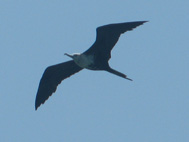
Wed. 6 May, 2009
Bird Species observed included 159 Red Knots (none tagged) and the same other species as previous recent day lists. Sanderlings
are gathering in very large flocks; as are Ruddy Turnstones so I guess they are getting ready to move. Only one
Double-crested Cormorant was observed so they've moved North and inland as have the "peep" Sandpipers. 3 White-tailed
Deer were observed back island at the 42 mile. Captured a photo of a beautiful adult black-bellied plover in breeding plumage (Pic below on the left).
Also, 4 Common Terns were observed which is "uncommon" for our area. The common tern is shorter legged but that black carpal bar (black stripe running
down the center of his folded wing) is the best dignostic for the species. (Common tern is in the center of the pic below on the right)
Capt. Billy L. Sandifer
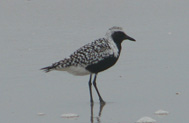
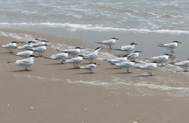
Tues. 5 May, 2009
Spent the day on PINS beach from end of pavement to 20 miles South of the pavement studying Red Knots with Audubon.
Water was murky to green and bait species and feeding birds were present. Saw one Jack Crevalle of 18 lbs. landed
at the 4 wheel drive sign and one big stingray extremely shallow and very probably injured by or hiding from a large
shark. Water choppy, no new Sargassum and windy to 29 mph out of the SE. Driving was good to fair.
Species observed included 209 Red Knots (none with tags), many Dulin, Plover species and Terns. Minimin of 600
Black Terns observed North of the 20. Other species as per previous reports with the exception of "peep" sandpipers
which see to have moved out. I am noticing a very low presence of Common Tern and as I am told numbers of this
species are becoming of concern I fear this lack of sightings could be indictive of that decline in overall population.
I am down there today and hope to get far South and update entire beach populations status. Had one male adult
Rose-breated Grosbeak and several Archilochus female Hummingbirds along with one adult male ruby-throated and one
Buff-bellied Hummingbird in the yard along with Mourning, White-winged and Inca Doves and Golden -fronted Woodpeckers
and Cardinals which literally live in my yard daily.
Capt. Billy L. Sandifer
Mon. 4 May, 2009
Mel Cooksey and Ron Weeks co-authored the latest ABA/Lane Birdifind Guide "A Birder's Guide To The Texas Coast."
This book is available through ABA, at PINS and I think at Barnes/Nobles Books and is a must for visiting birders.
Mel is reknowned for his birding skills and is a life long birder who has served in various positions within the
birding community. About 17 years ago he took me under his wing and has been my birding mentor ever since. Since
we both loved to fish and I shared his long term interest in genuinely studying the gulls and shorebirds that many
birders tend to avoid; it was a natural. I don't take time out to visit much but he called me yesterday afternoon
telling me of a massive number of Buff-bellied Sandpipers near Calallan and invited me to join him and I jumped at
the chance.
We met at 3:15 p.m. and I was back by 6:00 p.m.; so we birded and traveled a bit less than 3 hrs. 50 species were seen.
900 Buff-bellied Sandpipers were observed on a rather new sod farm on Highway 69 South of Highway 624. Mel says,
that is the largest concentration he's heard of occurring in at least the past 40 years. I'm not going to list all
50 species as I have to do a Red Knot Survey on PINS today with Audubon but among the "treats" seen were Pectoral,
Stilt and Semi-palmated Sandpipers. Wonderful full breeding plumage Wilson's Phalarope, Dunlin, Black Bellied Plover
and American Avocets. Fuluous Whistling Ducks, Diskcissel, Indigo Bunting, Gull-billed Terns, Rosette Spoonbills and
Neo-tropical Cormorant and Lesser and Greater Yellowlegs. There are good numbers of Archilochus female, 1 Ruby-throated
male and one Buff-bellied Hummingbirds hanging around our yard. Obviously, being able to see the massive group of
Buff-bellied Sandpipers made the day. I understand the Surfbird was seen again yesterday on the S. jetty at Port Aransas.
Below are some pictures of the Buff-bellied Sandpipers, 2 are displaying (photo by Jimmy Jackson). The second pic is a beautiful
Wilson's Phalarope on the pond at Hazel Bazemore Park.
It's all too good. Capt. Billy
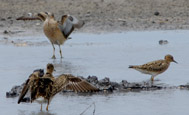
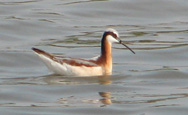
Sun. 3 May, 2009
Spent most of the day 45 miles West scouting Knolle Farms as I intend to add inland birding charters to my services
offered ONCE WE GET OUT OF THIS CURRENT DROUGHT. The Knolle Farm is quite large and located along the Nueces River
on the South side between Corpus Christi and Sandia, Tx. We saw many bird species including Green Jays and Great
Kisskadee but the brush country is bone dry and we missed other local specialties such as the Groove-billed Ani;
which are common there. We were mid day birding and could have gotten many more species if we had started earlier.
Got back to my house in Flour Bluff, Tx. and looking out the window I discovered there were 4 Baltimore Orioles
feeding on oranges side by side. As I watched them through binoculars an Indigo Bunting landed on a bush between
them and me so I assume we have a bit of a Neo-Tropical Fallout going on. Although I would not have expected it with
these steady strong SE winds. You just never know; unless you go.
Good Birding. Capt. Billy L. Sandifer
Sat. 2 May, 2009 Padre Island Nat'l Seashore
Conditions 76-90 degrees Winds to 38 SE 7' Swells. Muddy water. Fresh Sargassum. 1/2 sightseeing trip only went
28 miles past the pavement due to having children on the charter and rough conditions. Species observed: 106 Red
Knots between the 12 and 21 mile beach (none tagged), 1 Peregrine harrassing a Herring Gull 20 miles. 31 Cattle
Egrets migrating North along with 1 Tri-Colored Heron and 8 Blue-winged Teal.
Thursday April 30, 2009
Stuck at the house with articles and paperwork with SE winds forecast to blow 50 mph. Was really suprised to look out the window
and see a Blue Grosbeak. Yard talley for the day so far has included 2 Baltimore Orioles, 1 Indigo Bunting, 1 male and 3 female
Painted Buntings, 1 Scarlett Tanager, numerous Archilochus Hummingbirds, 1 ruby-throated male Hummingbird and our first Buff-bellied
Hummingbird of the year. This is quite late as we usually would have had a Buff-bellied by early March. One has lived all Summer
in our yard for years. We have Purple Martins living in 3 of our 4 Martin Houses.
Several Colonial Waterbird Nesting sites have been abandoned. I hope to be offering inland one day birding trips in the near future
in addition to the "Around Town" and PINS birding trips I currently offer.
Good Birding, Capt. Billy L. Sandifer
April 28, 2009
Tues. 28 April, 09'
Did a Red Knot survey from Bob Hall Pier to 32 mile beach of PINS. 7' Swells, fresh Sargassum and high SE winds and extremely
high tides made for a tough trip. The interest in Red Knots is due to the fact there is very little known about their presence
and movements through Texas and while David Newstead has observed one tagged Red Knot I have never seen one in the untold
thousands I've observed over the years. Supposedly 1 of every 10 East Coast birds have been tagged and it's really a
suprise to those involved with the Red Knot research that we have so many untagged birds migrating through our area.
We observed: 72 Red knots (none tagged), 2 Yellow Crowned Herons, 300 Cattle Egrets migrating and 3 Little Blue Herons migrating.
Many Dunlin and all of our usual Terns species are now present in good numbers. Caspian, Royal, Sandwich, Forresters, Common,
Gull-billed, Black and Least Terns were observed along with a good supply of Black Skimmers on their nesting colony near the NW
end of the raised JFK causeway. There is an unusually large number of Gull-billed Terns on the beach is due to the severity of
our current drought which may be causing a lack of inspects. I have never seen the large number of Red-winged Blackbirds stay
at our residence in Flour Bluff for the extended period of time they have this year and wonder if this might also be due to
the drought. Several Piping-Snowy and Semi-palmated Plover were observed and Wilson's Plover were common. 2 Wimbrel were
observed and 4 American Oystercatchers.Sanderlings, Willets and Ruddy Turnstones were in large numbers and often in large
groups. Many of the Terns are obviously already paired off.
Good Birding, Capt. Billy L. Sandifer
April 19, 2009
Bird Sighting Report Padre Island National Seashore 04/19/09
Conditions very heavy fog till noon with varying winds speeds and direction up to 30 mph.
Temperatures in the 70s and driving a 7 on a scale of 1-10. Seas were 6-7'. Distances are from the end of the pavement.
Species Observed:
Red Knots 251 highest # of year All North of the 24 mile
Franklins Gulls 331 all moving North in groups of 20 to 50
Snowy Egrets 350 resting and moving North
Cattle Egrets 80 resting and moving North
Little Green Heron 1 18 miles
Tri-Colored Heron 2 20 miles
Black Terns 17 First of the season All South of the 30 mile
Dunlin were almost as plentiful as Sanderlings. Most remain in basic plumage. A few beginning
To go into breeding plumage
Peeps (Least, Semi-palmated and Western Sandpipers) scattered along the entire beach in fair
Numbers. Most single birds.
Peregrine Falcon 1 40 miles in a.m.
Staging flocks of Willets, Ruddy Turnstones, Sanderlings along entire length of beach
Caspian, Royal, Sandwich, Forrester’s and Least Terns in small groups as are Laughing, Ring-billed and Herring Gulls.
Wilson Plover Numerous. Singles up and down the beachfront.
Long-billed Curlews Several sighted. Single individuals
Piping, Semi-palmated and Snowy Plover observed along beachfront.
White-tailed Hawk 1 on highway to PINS
Caracara 2- 19 miles
Stopped at Packery Housing on the way in and observed numerous Orchard Orioles, Archilochus Hummingbirds and one beautiful male Western Tanager.
On 04/20/09 Corpus Christi experienced the best Neo-Tropical Fallout this season so far. In my yard in Flour Bluff were 25 Baltimore Orioles, 1 Orchard Oriole, 2 Blue Grosbeaks, 1 Rose-breasted Grosbeak, Ruby Throated Hummingbirds, 1 Indigo Bunting and 1 Wormeating Warbler.
Numerous other Warbler species were observed at Blucher Park.
Good Birding, Capt. Billy L. Sandifer
|